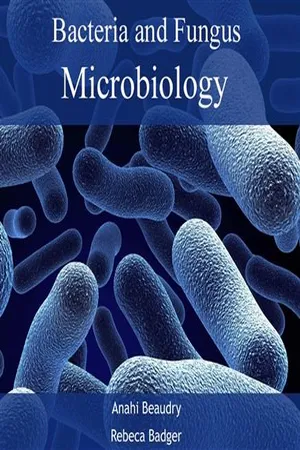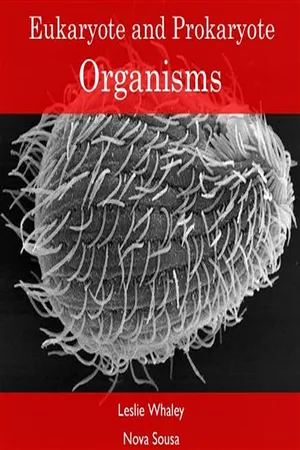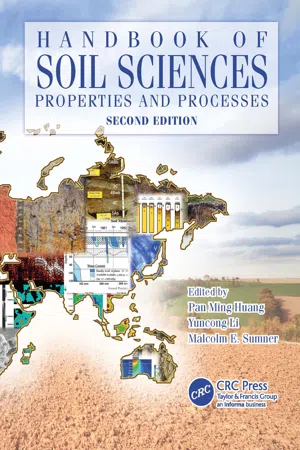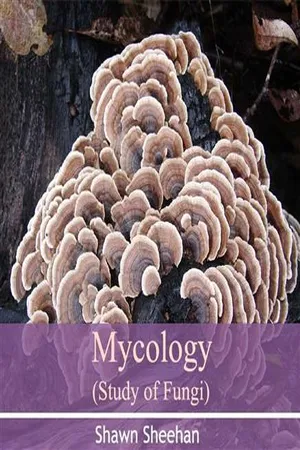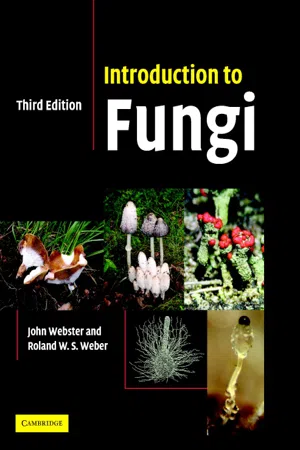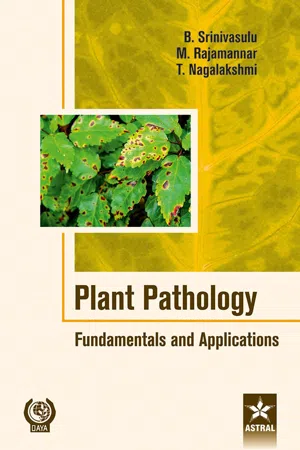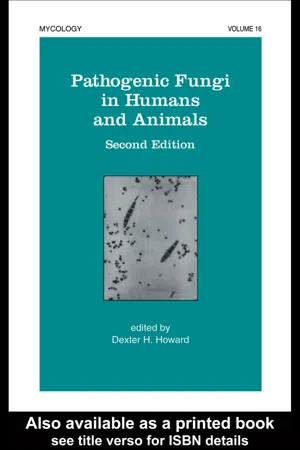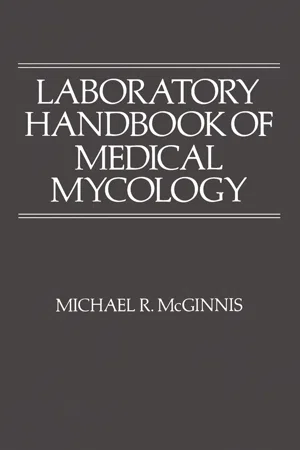Biological Sciences
Ascomycota
Ascomycota is a phylum of fungi characterized by the production of sexual spores within a sac-like structure called an ascus. This diverse group includes many important plant pathogens, as well as edible fungi like morels and truffles. Ascomycota play crucial roles in ecosystems as decomposers, symbionts, and pathogens, and have significant economic and ecological impacts.
Written by Perlego with AI-assistance
Related key terms
1 of 5
12 Key excerpts on "Ascomycota"
- eBook - PDF
- J. W. Deacon(Author)
- 2009(Publication Date)
- Wiley-Blackwell(Publisher)
Taxonomy and relationships The Ascomycota is considered to be a monophyletic group (all members sharing a common ancestry) that dates back to the coal age, at least 300 million years ago. This group is closely related to the Basidiomycota (the phylum containing mushrooms, etc.) as a sister group that shares similar features. Currently, the Ascomycota is divided into three subgroups, although the status of some of the early- diverging members is still unclear: 1 Archaeascomycetes, including the fission yeast, Schizosaccharomyces pombe, and some primitive plant pathogens such as Taphrina spp. (Fig. 2.17). 2 Hemiascomycetes – the true yeasts such as Saccharomyces cerevisiae, used to produce alcohol and for bread-making. These fungi do not produce ascocarps. 3 Euascomycetes, comprising the majority of species that produce hyphae and ascocarps. In addition to the main distinguishing feature, the ascus, the Ascomycota are characterized by cell walls composed primarily of chitin and glucans, by hyphae that have cross walls (septa; singular septum) at regular intervals but with a central pore that allows the passage of nuclei and other cellular organelles, and by the pro- duction of non-motile asexual spores (mitospores, termed conidia) that are produced in various ways, but never by cytoplasmic cleavage in a sporangium. The life cycle of Ascomycota We will use Neurospora crassa as an example to illustrate significant features of the life cycle of Ascomycota (Fig. 2.15). Neurospora grows as a branched network of hyphae with perforated septa, and produces aerial hyphae that terminate in branched chains of conidia (asexual spores). These are formed by a bud-like pro- cess involving swelling and repeated septation. When mature, the conidia develop a pink coloration and are easily removed from the hyphae by air currents. This cycle of sporulation, dispersal and spore germination occurs repeatedly when substrates are readily available. - No longer available |Learn more
- (Author)
- 2014(Publication Date)
- Academic Studio(Publisher)
________________________ WORLD TECHNOLOGIES ________________________ Chapter 12 Ascomycota Ascomycota Sarcoscypha coccinea Scientific classification Domain: Eukarya Kingdom: Fungi Subkingdom: Dikarya Phylum: Ascomycota (Berk. 1857) Caval.-Sm. 1998 Subphyla/Classes Pezizomycotina Arthoniomycetes Dothideomycetes Eurotiomycetes Geoglossomycetes Laboulbeniomycetes Lecanoromycetes Leotiomycetes ________________________ WORLD TECHNOLOGIES ________________________ Lichinomycetes Orbiliomycetes Pezizomycetes Sordariomycetes Unplaced orders Lahmiales Medeolariales Triblidiales Saccharomycotina Saccharomycetes Taphrinomycotina Neolectomycetes Pneumocystidomycetes Schizosaccharomycetes Taphrinomycetes The Ascomycota are a Division/Phylum of the kingdom Fungi, and subkingdom Dikarya. Its members are commonly known as the Sac fungi . They are the largest phylum of Fungi, with over 64,000 species. The defining feature of this fungal group is the ascus (from Greek: ἀ σκός ( askos ), meaning sac or wineskin), a microscopic sexual structure in which nonmotile spores, called ascospores, are formed. However, some species of the Ascomycota are asexual, meaning that they do not have a sexual cycle and thus do not form asci or ascospores. Previously placed in the Deuteromycota along with asexual species from other fungal taxa, asexual (or anamorphic) ascomycetes are now identified and classified based on morphological or physiological similarities to ascus-bearing taxa, and by phylogenetic analyses of DNA sequences. The ascomycetes are a monophyletic group, i.e., all of its members trace back to one common ancestor. This group is of particular relevance to humans as sources for medicinally important compounds, such as antibiotics and for making bread, alcoholic beverages, and cheese, but also as pathogens of humans and plants. Familiar examples of sac fungi include morels, truffles, brewer's yeast and baker's yeast, Dead Man's Fingers, and cup fungi. - No longer available |Learn more
- (Author)
- 2014(Publication Date)
- Academic Studio(Publisher)
________________________ WORLD TECHNOLOGIES ________________________ Chapter 9 Ascomycota Ascomycota Sarcoscypha coccinea Scientific classification Domain: Eukarya Kingdom: Fungi Subkingdom: Dikarya Phylum: Ascomycota (Berk. 1857) Caval.-Sm. 1998 Subphyla/Classes Pezizomycotina Arthoniomycetes Dothideomycetes Eurotiomycetes Geoglossomycetes Laboulbeniomycetes ________________________ WORLD TECHNOLOGIES ________________________ Lecanoromycetes Leotiomycetes Lichinomycetes Orbiliomycetes Pezizomycetes Sordariomycetes Unplaced orders Lahmiales Medeolariales Triblidiales Saccharomycotina Saccharomycetes Taphrinomycotina Neolectomycetes Pneumocystidomycetes Schizosaccharomycetes Taphrinomycetes The Ascomycota are a Division/Phylum of the kingdom Fungi, and subkingdom Dikarya. Its members are commonly known as the Sac fungi . They are the largest phylum of Fungi, with over 64,000 species. The defining feature of this fungal group is the ascus (from Greek: ἀ σκός ( askos ), meaning sac or wineskin), a microscopic sexual structure in which nonmotile spores, called ascospores, are formed. However, some species of the Ascomycota are asexual, meaning that they do not have a sexual cycle and thus do not form asci or ascospores. Previously placed in the Deuteromycota along with asexual species from other fungal taxa, asexual (or anamorphic) ascomycetes are now identified and classified based on morphological or physiological similarities to ascus-bearing taxa, and by phylogenetic analyses of DNA sequences. The ascomycetes are a monophyletic group, i.e., all of its members trace back to one common ancestor. This group is of particular relevance to humans as sources for medicinally important compounds, such as antibiotics and for making bread, alcoholic beverages, and cheese, but also as pathogens of humans and plants. Familiar examples of sac fungi include morels, truffles, brewer's yeast and baker's yeast, Dead Man's Fingers, and cup fungi. - No longer available |Learn more
- (Author)
- 2014(Publication Date)
- Academic Studio(Publisher)
The Ascomycota, commonly known as sac fungi or ascomycetes, constitute the largest taxonomic group within the Eumycota. These fungi form meiotic spores called ascospores, which are enclosed in a special sac-like structure called an ascus. This phylum includes morels, a few mushrooms and truffles, single-c elled yeasts (e.g., of the genera Saccharomyces , Kluyveromyces , Pichia , and Candida ), and many filamentous fungi living as saprotrophs, parasites, and mutualistic symbionts. Prominent and important genera of filamentous ascomycetes include Aspergillus , Penicillium , Fusarium , and Claviceps . Many ascomycete species have only been observed undergoing asexual reproduction (called anamorphic species), but analysis of molecular data has often been able to identify their closest teleomorphs in the Ascomycota. Because the products of meiosis are retained within the sac-like ascus, ascomycetes have been used for elucidating principles of genetics and heredity (e.g. Neurospora crassa ). ________________________ WORLD TECHNOLOGIES ________________________ Members of the Basidiomycota, commonly known as the club fungi or basidiomycetes, produce meiospores called basidiospores on club-like stalks called basidia. Most common mushrooms belong to this group, as well as rust and smut fungi, which are major pathogens of grains. Other important basidiomycetes include the maize pathogen Ustilago maydis , human commensal species of the genus Malassezia , and the opport-unistic human pathogen, Cryptococcus neoformans . Fungus-like organisms Because of similarities in morphology and lifestyle, the slime molds (myxomycetes) and water molds (oomycetes) wer e formerly classified in the kingdom Fungi. Unlike true fungi the cell walls of these organisms contain cellulose and lack chitin. Myxomycetes are unikonts like fungi, but are grouped in the Amoebozoa. Oomycetes are diploid bikonts, grouped in the Chromalveolate kingdom. - eBook - PDF
Handbook of Soil Sciences
Properties and Processes, Second Edition
- Pan Ming Huang, Yuncong Li, Malcolm E. Sumner, Pan Ming Huang, Yuncong Li, Malcolm E. Sumner(Authors)
- 2011(Publication Date)
- CRC Press(Publisher)
If true, appropriate species of these fungi could be vital in survival or restoration of rare or endangered vascular plant species, and the community of arbuscular mycor-rhizal fungi determines plant community diversity and produc-tivity (van der Heijden et al., 1998). 24.3.2.7 Kingdom Fungi, Phylum Ascomycota (Including Most Yeasts and Most Asexual Forms Previously Included in the “Deuteromycetes”) The Ascomycota include species of diverse nutritional modes, from saprotrophs through plant and animal pathogens, myco-parasites, and mycorrhizal associates. The Ascomycota include fungi that reproduce sexually through the production of meiotic spores in a cell called an ascus (plural asci), as well as their phy-logenetic relatives that are only known to reproduce asexually or rarely sexually. The inclusion of asexual relatives may seem obvi-ous to the nonmycological reader, but the tradition in mycology has been to recognize separate taxa for the sexual and asexual forms (e.g., Webster, 1981; Hawksworth et al., 1983). Filamentous asexual forms have been called imperfect fungi, fungi imper-fecti, deuteromycetes, hyphomycetes, or molds. There have been separate names and classifications all the way from genus and species (e.g., asexual Aspergillus nidulans versus sexual Emericella nidulans ) up to phylum (“Deuteromycota” versus Ascomycota, Margulis and Schwartz, 1988). The vast majority of deuteromycete species have not been connected with any sexual state (indeed, it is thought that many may not have a sexual state) (Seifert and Gams, 2001; Domsch et al., 2007). However, there are a number of morphological, physiological, and molecular criteria by which these fungi can be recognized as belonging to the Ascomycota (see later), so there seems little justification for retaining separate, artificial classifications above the level of the genus. - No longer available |Learn more
- (Author)
- 2014(Publication Date)
- Research World(Publisher)
Formerly part of the Zygomycota (commonly known as 'sugar' and 'pin' molds), the Glomeromycota were elevated to phylum status in 2001 and now replace the older phylum Zygomycota. Fungi that were placed in the Zygomycota are now being reassigned to the Glomeromycota, or the subphyla incertae sedis Mucoromycotina, Kickxellomycotina, the Zoopagomycotina and the Entomophthoromycotina. Some well-known examples of fungi formerly in the Zygomycota include black bread mold ( Rhizopus stolonifer ), and Pilobolus species, capable of ejecting spores several meters through the air. Medically relevant genera include Mucor , Rhizomucor , and Rhizopus . ________________________ WORLD TECHNOLOGIES ________________________ Diagram of an apothecium (the typical cup-like reprodu ctive structure of Ascomycetes) showing sterile tissues as well as developing and mature asci. The Ascomycota, commonly known as sac fungi or ascomycetes, constitute the largest taxonomic group within the Eumycota. These fungi form meiotic spores called as cospores, which are enclosed in a special sac -like structure called an ascus. This phylum includes morels, a few mushrooms and truffles, single -celled yeasts (e.g., of the genera Saccharomyces , Kluyveromyces , Pichia , and Candida ), and many filamentous fung i living as saprotrophs, parasites, and mutualistic symbionts. Prominent and important genera of filamentous ascomycetes include Aspergillus , Penicillium , Fusarium , and Claviceps . Many ascomycete species have only been observed undergoing asexual reproduct ion (called anamorphic species), but analysis of molecular data has often been able to identify their closest teleomorphs in the Ascomycota. Because the products of meiosis are retained within the sac-like ascus, ascomycetes have been used for elucidating principles of genetics and heredity (e.g. Neurospora crassa ). - eBook - PDF
- John Webster, Roland Weber(Authors)
- 2007(Publication Date)
- Cambridge University Press(Publisher)
Stalked ascocarps with well-preserved ascospores have been found in amber, the fossilized resin of a conifer. They have been assigned to an extant genus Chaenothecopsis (Mycocaliciaceae). Their close resemblance of present-day species which are also associated with resin indicate little evolutionary change during the past 20 million years (Rikkinen & Poinar, 2000). On morphological grounds, Barr (1983) suggested that the ancestors of Ascomycota should be sought among the Chytridiomycota. Confirmation of this view has since been obtained by comparison of DNA sequence data. Ascomycota are also closely related to Basidiomycota, each being a derived monophy-letic group (Bruns et al ., 1992; Berbee & Taylor, 2001). Berbee and Taylor (2001) have estimated that these two groups evolved from a common ancestor about 600 million years ago, well before the development of vascular terrestrial plants. 8.9 Scientific and economic significance of ascomycetes The study of ascomycetes is of considerable scientific importance. Neurospora crassa has been the subject of intensive genetical research related to its relatively simple nutrient require-ments, rapid growth, its capacity to produce 246 Ascomycota (ASCOMYCETES) mutants and the ease with which it can be grown and cross-mated in culture. The dissection of ascospores from its asci by micromanipulation has enabled tetrad analysis to be performed. Research on this fungus led to the important one-gene one-enzyme concept. Budding yeast ( Saccharomyces cerevisiae ) and a fission yeast ( Schizosaccharomyces pombe ) were amongst the first eukaryotes for which the entire genome was sequenced. Studies on S. cerevisiae were basic to the understanding of the biochemistry of anaerobic respiration whilst studies of S. pombe have provided key facts by which to interpret the fundamental process of cell division, which in turn has a bearing on the understanding of the apparently uncontrolled growth of cancerous cells. - Srinivasulu, B(Authors)
- 2018(Publication Date)
- Daya Publishing House(Publisher)
The yeasts, the black moulds, the common green moulds, the powdery mildews, the morels and the truffes are among the well known fungi under Ascomycotina. Just as the sporangium is the characteristic structure for the Mastigomycotina, so is the ascus for the Ascomycotina. The ascus is a sac-like structure containing a defnite number of ascospores which may vary from one to over a thousand according to the species formed as a result of This ebook is exclusively for this university only. Cannot be resold/distributed. sexual reproduction. Eight ascospores in each ascus is the typical number. Sexual reproduction in the Ascomycotina is by the union of two compatible nuclei, which are brought together by Spermatisation or gametangial contact or gametangial conjugation or Somatogamy. The two nuclei do not fuse soon but form a functional pair and undergo conjugate division resulting in a number of dikaryotic cells. Nuclear fusion takes place in the ascus mother-cell which develops into the ascus. Then meiosis of the diploid nucleus in the zygote occurs and four haploid nuclei are produced which divide once more mitotically and form eight nuclei which go to form eight ascospores in the ascus. Asci and Ascospores In many cases, the asci are elongated or club-shaped or cylindrical. In some, they are globose or ovoid or rectangular. In some the asci are septate. Asci may be stalked or sessile. Sterile elongated hairs arise between asci and these are known as paraphyses (singular – paraphysis). Ascospores vary greatly in size, from minute to more than 1000µm in length, in shape from thread-like to globose, and from hyaline to black and from one to many-celled. These characteristics are used as criteria in the classifcation. Ascocarps : Ascomycetes produce their asci in the fruiting bodies known as ascocarps. In general, the classifcation of the class is based according to the manner in which the asci are borne and are generally divided into four major categories.- eBook - PDF
- Dilip K. Arora(Author)
- 2003(Publication Date)
- CRC Press(Publisher)
32 Plectomycetes: Biotechnological Importance and Systematics Jlinta Sllgiyama The University Museum, The University of Tokyo, Tokyo and NCIMB Japan Co., Ltd., Shizuoka, Japan Hiroyuki Ogawa NCIMB Japan Co., Ltd., Shizuoka, Japan 1 INTRODUCTION The Ascomycota consisting almost 40% of known fungal species (ca. 80,000) is the largest phylum in the kingdom Fungi (Kirk et al. 2001). Within the Ascomycota the plectomycete species diversity is about 900 species accommodated in 90 genera, (including their related anamorphic species). Plectomycetes are of great importance for the following reasons: (a) they live in soil as saprophiles and decompose various substrates from sugar to cellulose and keratine, (b) useful in fermentation and related industries, (c) some of them cause mycosis or produce mycotoxins, and (d) the trichocomaceous species Aspergillus nidulans with an Emericella teleomorph is one of the model fungi for genetic studies and related disciplines. This chapter outlines the current status of plectomycete systematics, phylogeny, and evolution with emphasis on the economic importance of Aspergillus and Penicillium, and their related teleomorphs. 2 BIOTECHNOLOGICAL IMPORTANCE OF THE PLECTOMYCETES Plectomycetes, particularly members of the Trichocomaceae has well developed enzyme systems that are used in the beverage and food industries. Since the first enzyme takadiastase (invented by Jokichi Takamine) by A. oryzae was industrially produced in 1894, glucoamylase and amylase from black Aspergillus spp., pectinase from A. niger, and Penicillium notatum and proteases by Aspergillus spp. have been used in food processing (Berka et al. 1992; Novo-Nordisk Co.— http://www.novo.dk/enzymes/Technology.htm). - eBook - PDF
- Emea, A(Authors)
- 2018(Publication Date)
- Agri Horti Press(Publisher)
Cell Biology, Physiology and Mycology 244 separate and different nuclei in a single hyphal segment) in the life cycle usually has been interpreted as support for a close relationship between Basidiomycota and Ascomycota. Numerous phylogenetic studies such as SSU rDNA, RNA polymerase genes, and mitochondrial genome sequencing provide strong support for this relationship. A subkingdom termed Dikarya is proposed, creating a division between a highly speciose subkingdom (Dikarya) and the remaining early diverging lineages whose relationships are not precisely known. Fungal classification is far from static, and even which organisms are actually members of Fungi is changing. For example, the group trichomycetes describes gut inhabitants of arthropods that share similarities with zygomycetes. Molecular phylogenetic studies have demonstrated that two of the four orders of trichomycetes are actually members of the Mesomycetozoea protist group. Other organisms that were previously considered to be Fungi because of their heterotrophic, mold-like growth forms are now classified as stramenopiles (Oomycota, Hyphochytriomycota, and Labyrinthulomycota) or slime molds (Myxomycota, Plasmodiomycota, Dictyosteliomycota, Acrasiomycota). More interesting for mycologists are the findings that some species previously considered protozoa are actually Fungi. For example, the species Hyaloraphidium curvatum was assumed to be a green alga that had adopted a heterotrophic lifecycle concomitantly with losing its chloroplast. It is now known to be a chytrid fungus related to Monoblephariomycetes but lacking a flagellated stage. Other examples include the parasitic organisms presumed to be protozoa, such as the cockroach parasite Nepridiophaga and the Daphnia parasite Polycarum recently demonstrated to be members of the fungal kingdom based on SSU rDNA phylogenies. - eBook - PDF
- D.H. Howard(Author)
- 2002(Publication Date)
- CRC Press(Publisher)
1 An Introduction to the Taxonomy of Zoopathogenic Fungi Dexter H.Howard UCLA School of Medicine, Los Angeles, California, U.S.A. I. THE CLASSIFICATION OF FUNGI The subject of this book is the classification of zoopathogenic fungi. The basic units in classification are the species, and these are arranged into hierarchal groups of genera, families, orders, classes, phyla, and kingdoms. The categories may be subdivided (e.g., subphylum, subclass, suborder) to indicate degrees of relationships. Populations within a given species that have some characteristics in common may be set apart as tribes or varieties or some other subset designation. The delineation of the zoopathogen Ajellomyces capsulatus, anamorph: Histoplasma capsulatum, goes as follows (1): Kingdom: Fungi Phylum: Ascomycota Class: Ascomycetes Order: Onygenales Family: Onygenaceae Genus: Ajellomyces Species: Ajellomyces capsulatus Variety: the varietal state applies to the anamorph (2): Histoplasma capsulatum var. capsulatum, H. capsulatum var. duboisii, and H. capsulatum var. farciminosum Table 1 The Kingdoms and Phyla of Microorganisms Covered in This Book Kingdom: Fungi Phylum: Chytridiomycota Phylum: Zygomycota Phylum: Ascomycota Phylum: Basidiomycota Mitosporic Fungi a Kingdom: Straminipila Phylum: Heterokonta Kingdom: Protoctista Phylum: Protista a This group of anamorphic fungi—which lack any known teleomorphic stage—was at one time collected into a phylum Deuteromycota, but this term, still used for convenience in some arrangements (see, e.g., Chap. 8), has been largely discontinued. II. NOMENCLATURE OF HIERARCHAL GROUPS The pathogenic organisms traditionally considered as fungi* are now distributed among three biologic kingdoms: Fungi, Straminipila, and Protoctista (3). The bulk of this book is devoted to the members of the kingdom Fungi. Also included, however, is a consideration of the zoopathogenic members of the kingdoms Straminipila and Protoctista. - eBook - PDF
- Michael R. McGinnis(Author)
- 2012(Publication Date)
- Academic Press(Publisher)
Of these, approximately 175 or so species have proved to be agents of disease in man (Appendix C). The primary objective of a sound medical mycology laboratory is to identify the fungi recovered from clinical materials. Classification 47 A Fig. 139 Leptosphaeria tompkinsii. A and B. The asci and ascospores are produced within an ascostroma. The cavity is formed prior to the initiation of the asci. (Reproduced by permission of A. El-Ani and Mycologia from Mycologia 58 :406-411, 1966.) Many medical mycologists use the terms taxonomy and nomenclature interchangeably. Taxonomy deals with the classification of fungi and the characteristics that are considered to be important in distinguishing one fungus from the next. The purpose of taxonomy is to permit one mycolo-gist to readily communicate with another. The name given to each fungus in essence represents the sum of the knowledge of that fungus. As new information is discovered, it must be incorporated into our classification systems. Nomenclature on the other hand deals with the principles and 48 1 Basic Terminology and Classification Β Fig. 139 Continued rules for naming fungi. Nomenclature ensures that each fungus is named in a uniform and proper manner. There is much less flexibility in nomen-clature than in taxonomy. When first described, each different fungus is given a Latin or Latinized scientific name. Latin was selected because it is a dead language and is no longer subject to change as are our contemporary languages. The scientific name consists of two words, which are always underlined or italicized. The scientific name or binomial consists of a genus (pi. genera) name and a species epithet. Following the binomial, some mycologists write the name of the person who first named the fungus. Frequently, the year in which the new name was proposed is placed directly after the author's name.
Index pages curate the most relevant extracts from our library of academic textbooks. They’ve been created using an in-house natural language model (NLM), each adding context and meaning to key research topics.

